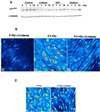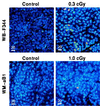Direct evidence for the participation of gap junction-mediated intercellular communication in the transmission of damage signals from alpha -particle irradiated to nonirradiated cells
- PMID: 11149936
- PMCID: PMC14611
- DOI: 10.1073/pnas.98.2.473
Direct evidence for the participation of gap junction-mediated intercellular communication in the transmission of damage signals from alpha -particle irradiated to nonirradiated cells
Abstract
It has generally been considered that important biological effects of ionizing radiation arise as a direct consequence of DNA damage occurring in irradiated cells. We have examined this hypothesis by exposing cells to very low fluences of alpha-particles, similar to those emitted by radon gas, such that as few as 1% of the cells in a population are traversed by a particle and thus receive any radiation exposure. By using the endpoints of changes in gene expression and induction of DNA damage, we show that nonirradiated "bystander" cells participate in the overall response of confluent density-inhibited populations of cultured fibroblast and epithelial cells. By in situ immunofluorescence techniques and the use of cells genetically compromised in their ability to perform gap junction intercellular communication, we present direct evidence for the involvement of connexin43-mediated intercellular communication in the transmission of damage signals to nonirradiated cells. Induction of the stress-inducible p21(Waf1) protein in aggregates of neighboring cells far exceeding the fraction of cells whose nucleus has been traversed occurred in gap junction-competent cells only. These changes in p21(Waf1) expression correlated with both the induction of DNA damage (as measured by micronucleus formation) as well as increased Ser-15 phosphorylation of p53.
Figures









References
-
- Nagasawa H, Little J B. Cancer Res. 1992;52:6394–6396. - PubMed
-
- Deshpande A, Goodwin E H, Bailey S M, Marrone B L, Lehnert B E. Radiat Res. 1996;145:260–267. - PubMed
-
- Nagasawa H, Little J B. Radiat Res. 1999;152:552–557. - PubMed
-
- Prise K M, Belyakov O V, Folkard M, Michael B D. Int J Radiat Biol Relat Stud Phys Chem Med. 1998;74:793–798. - PubMed
Publication types
MeSH terms
Substances
Grants and funding
LinkOut - more resources
Full Text Sources
Molecular Biology Databases
Research Materials
Miscellaneous

